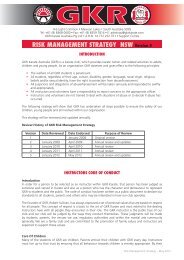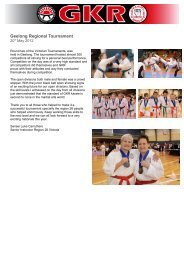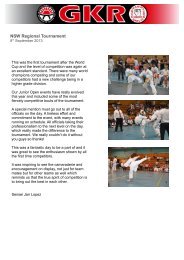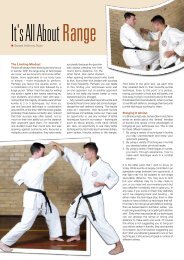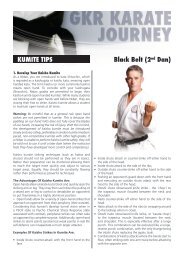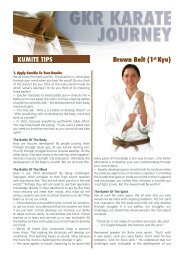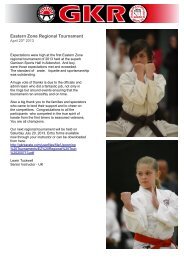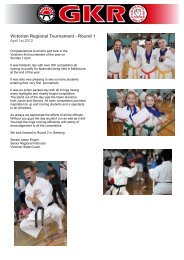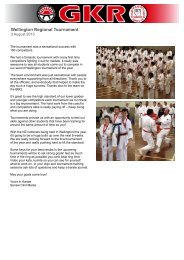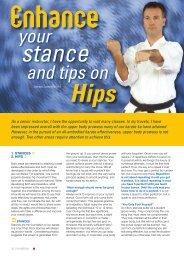You also want an ePaper? Increase the reach of your titles
YUMPU automatically turns print PDFs into web optimized ePapers that Google loves.
<strong>Kumite</strong> Tips<br />
<strong>Blue</strong> Belt (5 th Kyu)<br />
1. Show Your Knowledge<br />
As <strong>Blue</strong> belt insinuates that you have begun your journey<br />
as an advanced karate-ka, it’s vitally important that you<br />
start to bring your knowledge to the fore. Your ability to<br />
flow between stances should be relatively instinctive and be<br />
apparent when you spar. An example of this is to go from<br />
fighting stance, shifting forward to strike or kick, then shift<br />
back to a deep centre stance (to display zanshin) and then<br />
back to guard again. It should also show up in your ability<br />
to avoid toe-to-toe combat (getting in and out).<br />
Other pieces of knowledge that can show up in your kumite<br />
could be implementing principles of Taigyoku Shodan,<br />
Taigyoku Nidan and Saifa into your kumite:<br />
2. Perfect Your Timing And Distance<br />
It’s not just the technical aspects that you should be<br />
showing marked improvement in. Bruce Lee wrote that<br />
the two most important ingredients for combat are timing<br />
and distance.<br />
» With experience you should be starting to fine-tune<br />
your timing - knowing when to attack, when to defend<br />
and when to retreat.<br />
» But getting the timing right is only half the battle.<br />
Distance is equally important. To time your attack perfectly<br />
but start too far away means your opponent will have too<br />
much reaction time. If you start your attack too close and<br />
you risk being struck before you begin your own attack.<br />
Distance does not simply involve falling short or being<br />
scored upon. It also entails:<br />
a) Your power output. If you strike a target but are too<br />
close, your technique will not have room to develop full<br />
momentum. The result is less power. By contrast, if you<br />
strike a target but have had to over-extend your arm or<br />
body to reach it, you have passed your range of optimum<br />
power and will again result in a weaker strike.<br />
b) Your self-defence habits. Good distance does not always<br />
imply good control. Your knuckles might fall short of an<br />
opponent’s chin by 1cm. While this is ideal it does not<br />
represent good control if you only fell short because your<br />
arm could not reach any further. Good control means<br />
that you fall just short of a target with a well-bent arm.<br />
Hence the only reason why they were not injured was<br />
because you chose to pull the punch short.<br />
The only thing you want to change for self-defence is your<br />
arm. That is, you extend it in real life. Nothing else should<br />
change. If however you tend to strike at full reach during<br />
kumite then the only way you will be able to hurt a reallife<br />
attacker is by stepping closer (hence, adjusting your<br />
footwork). Changing habits in self-defence will not be easy.<br />
If however you create the perfect habit with your stance<br />
and footwork, and always pull your techniques short to<br />
ensure the safety of your opponent, in self-defence you<br />
only have to tell yourself one thing - “extend the arm!”<br />
The rest will take care of itself.<br />
3. Set Goals<br />
Whenever you spar it’s vital you have goals that you are<br />
working towards. Your goals should be progress and<br />
development focused rather than on dominating or<br />
winning. Setting goals will help your kumite journey by:<br />
a) Keeping kumite new and exciting.
) Give you specific things to focus and work on.<br />
c) Allow you to assess your progress and development.<br />
d) Allow you to measure your overall progress.<br />
Prior to <strong>Blue</strong> belt, each of your gradings were only 3-4<br />
months apart (assuming you’ve been consistent with<br />
your training etc). The time between <strong>Blue</strong> and Red belt is<br />
greater than all previous belts and as such, students can<br />
find themselves without a carrot to motivate them. This is<br />
where goal setting comes in, not just in kumite, but also in<br />
every area of your karate.<br />
» As karate is a Way of Life, you need to implement this<br />
strategy to improve your overall quality of life. You can<br />
set goals for your health, your attitude, your personal life,<br />
work, schooling, family etc. There are numerous articles on<br />
goal setting in the Life Category of the Articles section of<br />
this website.<br />
4. Faster Hip Rotation<br />
Bassai-dai focuses on dynamic hip rotation. This is because<br />
the hips play an enormous role in self-defence. Some of<br />
these include:<br />
a) Adding power to our techniques.<br />
b) Adding reach to our techniques.<br />
c) Adding speed in the transitions between stances.<br />
d) Keeping us protected from an opponent’s strikes.<br />
e) Breaking free from an opponent’s grip.<br />
Allow this focus on hip movement in Bassai-dai to transcend<br />
into your kumite. Aim to use dynamic hip movement<br />
in your strikes (and also the rapid retraction of the hips<br />
immediately after the strike).<br />
» If you have tight hips, then you will need to speak with<br />
your instructor about setting up some extra stretching<br />
exercises at home, so that you can work to improve the<br />
flexibility and mobility in and around your mid-section and<br />
hips.<br />
5. Introduce More Combination Attacks<br />
Up until now we have recommended that you keep your<br />
combination attacks to two techniques. By spending ample<br />
time on singular and double techniques we could ensure<br />
our footwork, weight distribution, stances, power output<br />
etc were not being compromised while attacking.<br />
» Now that you have reached <strong>Blue</strong> belt you should be<br />
getting a good grip on this. While you may be far from an<br />
expert you can look to introduce multiple attacks, perhaps<br />
3, 4 or more attacks in a burst.<br />
» Attacking in bursts will help you to develop muscular<br />
strength and speed, coordination and confidence.<br />
Once again you need to assess whether or not you are<br />
compromising important principles of attack while doing<br />
this.<br />
6. Start Feinting With Your Legs<br />
At Green belt we recommended you start developing<br />
your feinting with hand techniques. We did not suggest<br />
you start feinting with leg techniques as an inexperienced<br />
karate-ka will often bring themselves undone feinting<br />
with kicks. This is because they find themselves in a poor<br />
position (poor stance, balance, distance etc).<br />
Now you have reached <strong>Blue</strong> belt you can start using your<br />
legs to feint. Just a few examples of this include:<br />
a) Feinting with one kick (eg, a front kick off the back leg)<br />
and once the opponent reacts to this (eg, by lowering<br />
their guard), turning it into an entirely different kick<br />
(eg, a round kick off the same leg) and aiming for an<br />
unguarded area.<br />
This technique is often called a change-up. The key to<br />
success is to make the first kick convincing to draw their<br />
guard away. In order to get the most of this technique,<br />
don’t stop mid kick and change techniques. Allow it to<br />
flow from one kick to the other fluently.<br />
b) Feinting with a kick (eg, a head level round kick off the<br />
front leg) and once the opponent reacts to this (eg, by<br />
raising their guard and leaning back slightly), to quickly<br />
drop the leg straight back on the ground and then extend<br />
the same foot out quickly and punch to the body.<br />
c) Feinting with one kick (eg, a front kick off the back leg)<br />
and once the opponent reacts to this (eg, by retreating<br />
back), to quickly step this leg forward (closing the<br />
distance) and launch a secondary kick off the back<br />
foot.<br />
7. Start To Develop Your Sen-No-Sen (Anticipation<br />
Techniques)<br />
In terms of defence, throughout your kumite journey<br />
to date, we have suggested you develop two senjutsu<br />
(combat strategies).<br />
a) Create distance:<br />
This can be done via retreating or using tai-sabaki (sidestepping).<br />
The upside to this strategy is that it keeps you<br />
safe from an attacker’s strike. The downside is we have not<br />
inflicted any pain on them; therefore you can be sure a<br />
follow up strike will soon follow.<br />
i) If you find that your movements to create distance<br />
generally have the attacker launching follow-up<br />
technique after follow-up technique, then it suggests<br />
you need to start breaking on a sharper angle. The<br />
sharper your angle the more you can get to the<br />
outside of your attackers body (toe-to-side combat -<br />
a principle of Saifa). An opponent will find it difficult<br />
to launch a follow up technique if their opponent<br />
(you) is on a 90-degree angle to them. So if you do<br />
not move far enough back, or break on a poor angle,<br />
your opponent will still see an opportunity to score<br />
and continue striking.<br />
ii) If however you do find that you create enough
distance so that your opponent does not bother to<br />
attempt a follow-up technique, but you yourself find<br />
yourself too far away to counter strike, then you need<br />
to minimise your movement.<br />
In short, if you move too far then you risk being able to<br />
take advantage of an opponent who lacks zanshin after<br />
their attack/s. An advanced karate-ka can always maintain<br />
good distance, far enough (or sharp enough an angle) to<br />
de-motivate their opponent from follow ups, but still close<br />
enough to be able to launch their own counter strikes.<br />
» Achieving this balance take lots of practise and is a<br />
useful tool for self-defence.<br />
b) Go-no-sen (block and counter):<br />
The disadvantage to this senjutsu is that your block<br />
must be successful or your opponent will succeed with<br />
the attack. The advantage of this senjutsu is that should<br />
your block be successful, you are in a position to take<br />
advantage of many open targets.<br />
We have said on more than one occasion that a person<br />
is never more open and vulnerable (both mentally and<br />
physically) than when they attack.<br />
» A more advanced method of dealing with the attacker’s<br />
vulnerability is the anticipation strike, or pick off. The<br />
Japanese term for this is ‘sen-no-sen’. We have not<br />
suggested developing this technique until now because it<br />
requires:<br />
i) Acute timing<br />
ii) Quick technique (free of any excess movement)<br />
iii) Quality zanshin (continued state of awareness)<br />
If any of the above ingredients are missing you will find<br />
yourself in deep water. This is why we have only suggested<br />
for you to develop your counter-attacking abilities until<br />
now. Having reached <strong>Blue</strong> belt is not a sign to switch from<br />
go-no-sen (counter attacking) to sen-no-sen (anticipating).<br />
It’s merely a sign to suggest that you start thinking about<br />
this technique.<br />
It involves reading your opponents body language (one<br />
reason why it’s a more advanced technique). Then, when<br />
the opponent starts their attack, before they can put it<br />
into full swing, move in with your own technique. Your<br />
technique should not only land first, it should prevent them<br />
from ever finishing theirs.<br />
This technique will take years to develop but is highly<br />
effective in self-defence. It’s worth noting that it is much<br />
easier to use in self-defence because:<br />
i) You will unlikely be up against a trained attacker.<br />
ii) Your attacker is unlikely aware that you train in martial<br />
arts.<br />
iii) Your attacker will likely throw swinging techniques,<br />
which are much slower than the karate lunge or<br />
reverse punch.<br />
8. Develop Your Ibuki (Breathing)<br />
With so much to think about during kumite, students<br />
often find themselves tiring very quickly. The problem may<br />
not be their fitness, but rather because they are holding<br />
their breath.<br />
The Japanese term for ‘breathing technique’ is Ibuki-waza.<br />
Correct breathing enhances a number of things:<br />
a) Energy conservation - Oxygen is fuel for your muscles.<br />
By feeding your muscles ample supplies of oxygen your<br />
endurance will increase greatly.<br />
b) Muscle relaxation - Which in turn increases speed, power<br />
and mobility.<br />
c) Concentration and focus - When our body is starved of<br />
oxygen we lose our ability to focus and strategise. The<br />
body’s natural preservation takes over and it focuses on<br />
one thing, oxygen supply.<br />
While you have been told to ‘breathe’ your entire karate<br />
life, it’s time to put some focus on this.<br />
» One simple formula is to always ensure you put as much<br />
oxygen in as you put out. This is a formula students get<br />
drastically wrong in every aspect of their karate (kihon,<br />
kata and kumite). They expel big breaths when they strike<br />
but focus too little on deep breaths in.<br />
» A better formula would be to focus on consistent breaths<br />
in and expelling only a small breath out when striking.<br />
» Next time you spar, take some time to assess your<br />
breathing. Do you rarely breathe in? Do you breathe out<br />
too much when striking? Do you hold your breath at all?<br />
Combination attacks and combination defences are<br />
generally where students tire themselves out through poor<br />
breathing. They will either:<br />
i) Hold their breath through an entire combination (of<br />
attacks or blocks).<br />
ii) Breathe out deeply on each and every technique.<br />
The key is to expel very small and light breaths through a<br />
combination, so that the total of each breath would add<br />
up to one regular breath with a single technique.<br />
• There are many articles on breathing in the Articles<br />
section of this website. You will find them in the ‘Training<br />
Category’.<br />
9. Take Down Your Opponent’s Guard<br />
At Green belt we introduced you to the strategy of feinting.<br />
One of these involved feinting an attack in one direction to<br />
draw your opponent’s attention and guard away from your<br />
actual desired target area.<br />
» Another way to get to a protected target is to push their<br />
guard out of the way. In the kata Bassai-dai this occurs<br />
a number of times where we crescent kick an opponents<br />
guard to open up their head and floating ribs (note this is<br />
just one bunkai for these techniques).<br />
» While this technique can be done with kicks, it’s far
more effective and simple to use your hands to attack the<br />
guard of your opponent, clearing the path for the follow<br />
up strike.<br />
You can come up with many ways to achieve this in kumite.<br />
The following are just two simple examples:<br />
a) Altering your lunge, reverse punch combination. Instead<br />
of executing the lunge punch in its normal fashion,<br />
extend it out just above the opponent’s front hand,<br />
then pull the hand down a level, opening the way for a<br />
reverse punch to the head. This is actually a bunkai of<br />
the first two counts in Taigyoku Shodan.<br />
b) When your front foot is directly in front of your<br />
opponent’s front foot, use your front hand to push your<br />
opponent’s front hand across their body (opening up<br />
the ribs) and then execute a reverse punch to the body.<br />
10. Developing Various Types Of Footwork<br />
(Ashi Sabaki)<br />
In terms of attacking footwork (ashi-sabaki), thus far in<br />
your journey we have recommended that you focus on:<br />
a) Start from a fighting stance that evenly balanced<br />
between mobility and solidity.<br />
b) Staying low at all times.<br />
c) When striking, moving quickly into a quality stance<br />
similar to long forward stance (eg, two shoulder widths<br />
long, front knee well bent, front knee over the ankle,<br />
implementing hip movement).<br />
d) Immediately after striking, ripping the hips back with<br />
the arm and returning to a solid stance (similar to<br />
sumo, horse riding or back leaning) for a short period<br />
(representing zanshin). This will allow to defend against<br />
a strike, grab or tackle in the close range you are, or<br />
to launch a powerful follow up attack. Then moving<br />
quickly out of this back to fighting stance.<br />
What we have not offered you to date is the many means<br />
for getting to your striking stance (although many of these<br />
are found in the kata and are covered in drills during<br />
class).<br />
» Having reached <strong>Blue</strong> belt, it’s time you really stated to<br />
develop your footwork.<br />
» In cricket, footwork can be the difference between<br />
smashing the ball to the boundary and nicking it behind to<br />
the wicket keeper. In soccer, footwork can be the difference<br />
between putting the ball in the top corner of the net or a<br />
mile over the bar. In tennis, it can be the difference between<br />
hitting the ball into the corner for a clear winner or have it<br />
sail over the baseline. There’s no denying footwork plays a<br />
monumental role in any sport – including karate. When it<br />
comes to kumite, footwork (ashi sabaki) is everything! It’s<br />
a karate-ka’s greatest weapon or most costly liability.<br />
The Test<br />
If you were to randomly pick 100 students of all ages<br />
and grades, then run through the ‘Basics’ with them, the<br />
difference (in terms of speed) between the fastest and<br />
slowest punch would be a millisecond. So if this is the case,<br />
why then in kumite will one person score eight times out of<br />
ten and another score once out of ten? The answer is very<br />
simple, footwork! Despite its paramount importance, it is<br />
still the single biggest thorn in the side of most karate-ka.<br />
And if it lets you down in the dojo (and in a tournament),<br />
then it is likely to let you down in real life.<br />
Why Ashi Sabaki Eludes Most <strong>Karate</strong>-ka<br />
If footwork is so important, why is it so underdeveloped,<br />
even amongst high grades? We’ve been moving around<br />
since infancy. We chased after our friends when playing<br />
tip, ran away from waves at the beach, ran to catch the<br />
school bus, we dodged, we tackled and played numerous<br />
sports. And regardless of the activity, we never needed to<br />
change our movement; the simple act of running served<br />
us perfectly each and every time. And then we stumbled<br />
across another activity – kumite. We were standing in our<br />
spot and our opponent was standing in theirs, some feet<br />
away. Somehow we needed to get ‘over there’ to attack,<br />
or somehow we had to get away to avoid their attack. It<br />
seemed so logical, just do the very thing that has served<br />
you all your life…run!<br />
Ashi Sabaki Won’t Improve Until You Appreciate It<br />
If you were to watch a video of yourself sparring, would<br />
you see yourself running in to attack? Would you see<br />
yourself running away to avoid attack? If you’re 80% of all<br />
karate-ka, you’ll be answering, “Yes” to both questions.<br />
So the first point to note is that running is NOT footwork.<br />
Running may serve you in most sports, but it is completely<br />
useless in combat (unless of course you are literally running<br />
away). Now at this point you may be disagreeing. You run<br />
in strongly for your attacks and they seem to serve you just<br />
fine. The problem is, we don’t feel the negative impact<br />
of running in the dojo so it often appears to work in our<br />
favour.<br />
» Before we discuss the downsides of running, here<br />
are two questions. How many <strong>GKR</strong> kata have us ‘run’<br />
from technique to technique? None! How many <strong>GKR</strong><br />
kata have us move from technique to technique using a<br />
footwork methodology? Every…single…one! There must<br />
be some reason why we spend hours practising kata and<br />
combinations that have us moving through our techniques<br />
with footwork.<br />
Running Versus Ashi Sabaki<br />
There are countless downsides to running. Hopefully once<br />
you grasp any number of these, you will embark on some<br />
ashi sabaki training for your kumite. From a defensive point<br />
of view, when we run away to avoid attack we raise our<br />
centre of gravity. This works in the dojo for two reasons.<br />
Firstly, because we have ample room to move and secondly,<br />
because our opponent is abiding by the rules of kumite.<br />
» Considering kumite should train us for real life selfdefence,<br />
it’s not enough to say, “It works fine in my dojo.”<br />
In real life, you may have limited space (like your kitchen,<br />
a car park etc). As running raises your centre of gravity
and takes you out of stance, in a limited area you will find<br />
yourself in a vulnerable position – an easy target for a strike<br />
or tackle.<br />
» Martial artists from grappling styles often use the<br />
argument, “Most fights end up on the ground.” Probably<br />
true, but how many fights entail a person who understands<br />
the importance of stance and centre of gravity? Beyond this,<br />
a martial artist should be ready at all times during combat.<br />
If you are running away, from where can you launch a<br />
telling counter strike? Contrarily, if you use footwork you<br />
will always have a low centre of gravity and be in stance,<br />
implying, not only can you avoid attacks in small areas,<br />
you can execute a powerful counter strike the moment the<br />
opportunity arises. But what of the offensive perspective?<br />
The Goal Of Any Attack<br />
When attacking, you should have a number of goals in<br />
mind. These are:<br />
Defence: Always attack with defence in mind.<br />
Speed: Be faster than your opponent’s reaction.<br />
Power: Aim to finish the opponent with one technique<br />
(ikken hisatsu).<br />
Reach: To maintain your karate advantage, avoid moving<br />
into their ‘grappling/tackling’ zone when striking.<br />
Zanchin: After your attack, be in stance, at good distance<br />
in case defensive measures or further strikes are required.<br />
So let’s compare how running in to attack measures up<br />
with our goals.<br />
Defence: Running raises your centre of gravity; hence<br />
outside the ‘rules of the dojo’ you’re vulnerable to be<br />
tackled to the ground. This is why most real life fights<br />
end up on the ground, one attacks standing tall and the<br />
other goes back to their rugby habits and tackles them to<br />
the ground. In simple terms, they attacked without any<br />
thought for their defence.<br />
Speed: Running is drastically slower than footwork (once<br />
practised). This is because multiple small steps will not be<br />
faster than one or two large steps.<br />
Power: Running zaps almost all your punching power. Try<br />
running at a punching bag and hitting it – you’ll find it<br />
hardly moves. This is not how power is derived. Power is<br />
best achieved by short, sharp bursts (as with footwork).<br />
Maximum power is only really achieved through a low<br />
centre of gravity (as found in footwork).<br />
Reach: When you run you are virtually standing, and so<br />
your reach is drastically reduced. From a long zenkutsu-like<br />
fighting stance, you can add 15-30cms to your reach.<br />
Zanchin: When you run, you are unable to stop at a point<br />
of your choosing. People who run to attack rely on their<br />
opponent to run away. While this often occurs in the dojo,<br />
it almost never occurs in real life. Using footwork on the<br />
other hand, allows you to execute a faster, more powerful<br />
strike, with more reach, and still enables you an opportunity<br />
to stay in karate distance (leaving them no opportunity to<br />
grab you and take your karate advantage away). Coming<br />
in with footwork also allows you the opportunity to quickly<br />
retreat.<br />
» The purpose of footwork is to economically shift our<br />
body, creating speed and force to techniques in attack. It<br />
allows us to be in the right place at the right time, and to<br />
be in the right position to do something about it. Footwork<br />
also allows us to quickly create distance in defence while<br />
maintaining balance.<br />
» Hopefully by now you’re enlightened to the advantages<br />
of ashi sabaki and have become more sceptical towards<br />
your current habit of running during kumite. If so, then<br />
take the following footwork exercises on board and work<br />
on them until they are instinctive. Remember that running<br />
is natural while ashi sabaki is not; so don’t be discouraged<br />
if things don’t click right away. You may even be fighting<br />
months or years of bad habits. Be patient, as it will not<br />
only prepare you better for self-defence, it will dramatically<br />
improve your kumite in the dojo and tournaments.<br />
Footwork Drills<br />
Footwork Drill One: Oi Ashi<br />
From fighting stance, your front foot extends out to a<br />
Zenkutsu-like stance. Upon completing the attack, the<br />
same foot comes back to its original position. Oi ashi<br />
(lunging feet) is the most basic of all ashi sabaki and the<br />
ideal technique when an opponent is in 1-2 feet away<br />
(making it an excellent technique for real life situations). Its<br />
aim is to enter with a powerful strike, then escape before<br />
a grab or counter strike is forthcoming.<br />
Footwork Drill Two: Yori Ashi<br />
From fighting stance, the front foot moves out (lengthening<br />
the stance) then the back leg quickly comes up behind,<br />
snapping you back to fighting stance again. When<br />
practising yori ashi (sliding feet), try to avoid the common<br />
mistake of simply pushing forward off the back leg. To get<br />
more power, reach and speed, simultaneously use your<br />
front leg to pull your body forward. Once your front foot<br />
hits the ground, don’t drag your back leg up behind it. If<br />
the back foot drags behind, it works like an anchor, taking<br />
away from the technique. The back leg must race back into<br />
place, allowing you the ability to reload another technique<br />
and move again.<br />
» Yori ashi is the most common method of footwork<br />
and the quickest for bridging the gap. Ideally used with a<br />
head-level lunge punch when your opponent is only 2-3<br />
feet away, or to begin a combination of attacks (such as<br />
a lunge/reverse punch combination). It is a wise choice<br />
of footwork when your opponent is good at pick offs or<br />
when they are likely to back off slightly when you attack.<br />
Being the quickest, it is also the weakest. The goal behind<br />
yori ashi would be to move into and take your opponent’s<br />
space after your technique.<br />
Footwork Drill Three: Sugi Ashi<br />
Sugi ashi (shuffling feet) works the opposite way to yori<br />
ashi (sliding feet). From fighting stance, bring your back<br />
foot up first (either all the way or halfway, depending on
the distance between you and your opponent) to greatly<br />
shorten your fighting stance. Then like a chain reaction,<br />
launch out oi ashi. Your front foot shooting out to a<br />
zekutsu-like stance with the attack, and upon completing<br />
the attack, bring your front foot back slightly coming back<br />
to a very low sumo-like or back-like stances.<br />
» Sugi ashi is a little slower than yori ashi but it covers more<br />
distance and adds far more power. Ideally used when your<br />
opponent is on the back foot or momentarily off rhythm. It<br />
is a wise choice of footwork when your opponent is likely<br />
to block or move back slightly instead of picking off. Most<br />
karate-ka only use sugi ashi when executing kicks off the<br />
front foot, but it is best used with a reverse punch.<br />
» It is vital when bringing the back foot up that you don’t<br />
come up too much in height as this will take away power<br />
and slow you down. It’s also imperative you finish in a low<br />
sumo-like or back-like stance as this prevents an attacker<br />
from grappling you and puts you in position to launch<br />
another attack. The goal of sugi ashi is not to replace your<br />
opponent’s position, but to come in and out again.<br />
minimise the time taken between the first and second<br />
technique. The longer this pause the longer your opponent<br />
has to prepare a counter or follow up block. It is also the<br />
goal to utilise two karate principles – Ikimi and Itsoku.<br />
» Ikimi is the principle of floating. When moving through<br />
with ashi sabaki you should avoid any tension in the legs.<br />
They should move through light and swift as though<br />
floating. The moment you make contact with the ground<br />
(and punch) you should adopt itsoku.<br />
» Itsoku is the principle of being glued to the floor. Many<br />
karate-ka make the habit of adopting only one principle.<br />
They either use ikimi right through, hence they are light<br />
and fast but never achieve full power or balance. Others<br />
are habitual with their itsoku. These people are strong and<br />
stable, but lack speed and agility because they are stiff<br />
throughout their movement.<br />
Footwork Drill Four: Ayumi Ashi<br />
Ayumi ashi (walking feet) resembles the most common<br />
footwork found in kata and combinations. From fighting<br />
stance, the back leg steps right through to become the<br />
front foot. Unlike walking, as the leg steps through, it is the<br />
balls of the feet that hit the ground first, not the heels.<br />
» Most karate-ka only use ayumi ashi when kicking off the<br />
back leg, but is most devastating when used with punches.<br />
It is rarely seen with punches as most karate-ka believe it to<br />
be the slowest of all footwork techniques. But this is only<br />
the case because most do not understand the timing. In<br />
combinations and kata, we hold our technique back until<br />
the foot is landing. In kumite however, the objective is to<br />
land the strike before the feet even cross. The methodology<br />
behind the technique is that by committing to step through,<br />
it adds enormous power to the technique, plus it has the<br />
ability to hunt down a quickly retreating opponent.<br />
» Ayumi ashi allows one to move quickly and smoothly<br />
into the opponent’s space. It should feel as if riding on<br />
wind. Be careful not to come up in height or it will leave<br />
you susceptible for a pick off, not to mention that it will<br />
slow you down.<br />
Footwork Drill Five: Yori Ashi, Oi Ashi Combination<br />
This is a two-punch combination consisting of a lunge<br />
punch followed by a reverse. While many karate-ka can<br />
exercise this punching combination, many fail to get the<br />
footwork correct, the result, less speed, distance, power,<br />
balance and zanshin.<br />
» The front foot pushes out with a lunge punch, the back<br />
foot quickly comes up behind completing yori ashi (sliding<br />
feet). The moment the back foot hits the floor, the front<br />
foot explodes out with oi ashi (lunging feet) with a reverse<br />
punch. After the reverse punch, the front foot comes back<br />
slightly to make a deep centred stance (a stance strong<br />
enough to prevent a would-be counter-tackle).<br />
Ikimi And Itsoku – The Final Ingredient<br />
When executing combination attacks, it is your goal to



